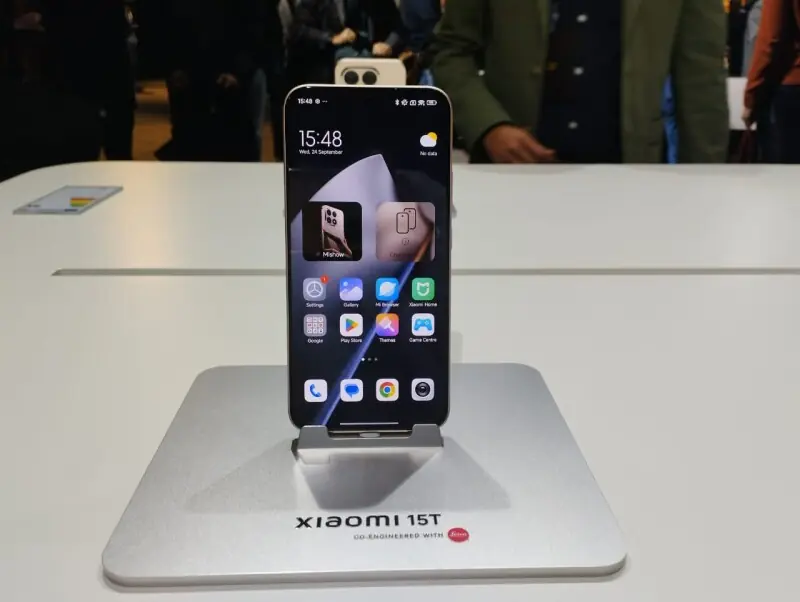Chinese smartphone giant Xiaomi is deepening its global strategy by partnering with Europe’s Leica – known for producing high-quality cameras – and America’s Google Gemini, an artificial intelligence (AI) assistant. Industry experts describe the move as an effort to strengthen its “challenger” status in the global smartphone market.
During the launch of the new Xiaomi 15T series, Terrence Xiao, Senior Product Marketing Manager at Xiaomi International, said while business expansion was important, the company’s immediate focus with such collaborations was user experience.
“As a business we are always trying to increase our market share,” Xiao responded to a Business Recorder query at a media briefing following the launch of the 15T series held recently in Munich, Germany.
“However, our number one priority for collaborating with amazing brands like Leica and Google is not necessarily from a business perspective. It is very user driven. So we are always super excited to bring the best experiences that we can with Leica for our camera system, and Google in terms of AI capabilities and software experiences.”
When directly asked whether these partnerships are expected to boost market share, Xiao gave a brief but telling answer: “Sure, we can hope so.”
Founded in 1869 by Ernst Leitz, Leica Camera AG is a German company best known for its high-end cameras and optical lenses. Meanwhile, Google’s Gemini, the American tech giant’s advanced generative AI, is being integrated into Xiaomi’s new series to enhance on-device intelligence, personalisation, and user software experiences.
Xiaomi collaborates with Leica to unveil 15T series with focus on mobile photography
Analysts see this dual collaboration as more than just a technical upgrade.
Habibullah Khan, a Pakistani digital economy expert, said Xiaomi is leveraging what is known as the “halo effect” – a marketing concept where the positive perception of one product or brand influences consumer attitudes toward another.
“Xiaomi is a challenger company in the mobile phone industry. Challengers have to show an extra edge versus large well-known incumbent brands like Apple or Samsung and they turn to co-branding to produce the halo effect,” Khan told Business Recorder.
“Challengers do what I call halo branding to increase their market share, while incumbents try to defend their share by incremental product upgrades.”
Khan, who is also founder and CEO of design studio Penumbra, added that Xiaomi’s strategy also reflected internationalism in its co-branding approach.
“By collaborating with European legacy camera makers and American generative AI providers, Xiaomi is positioning itself as a global brand, not just a Chinese one.”
Ali Abbas, a leading tech YouTuber and smartphone influencer in Pakistan who runs the channel Mastech, said Xiaomi 15Tpro was a camera-centric phone. He noted that the collaboration benefited both brands, while Xiaomi gained from Leica’s expertise in lenses and imaging, Leica’s technology also reached a wider audience through Xiaomi, which ranks among the top three smartphone brands globally, including in Europe.
A number of photography enthusiasts who couldn’t afford Leica’s high-end DSLRs could now experience its camera quality through the phone, Abbas added.
Market data shows the company has reason to be ambitious. According to the International Data Corporation (IDC), Xiaomi holds a 14.4% global market share and has ranked in the world’s top three smartphone makers for 20 consecutive quarters.
The company shipped 42.4 million smartphones in the second quarter of 2025 alone, maintaining growth despite a sluggish global market.
In financial terms, Xiaomi’s smartphone segment generated RMB45.5 billion ($6.4 billion) in Q2 2025. A company update highlighted that “new device activations continued to lead in Mainland China” after Xiaomi regained the top spot in shipments earlier this year.
The company has also been pursuing what it calls a premiumisation strategy, aiming to compete in higher price brackets traditionally dominated by Apple and Samsung.
According to data cited by Xiaomi, sales of premium smartphones in Mainland China accounted for 27.6% of its total in Q2—up 5.5 percentage points year-on-year. Its share in the RMB4,000–5,000 ($550–680) range rose to 24.7%, while in the RMB5,000–6,000 ($680–820) bracket, it reached 15.4%.
Industry watchers say the real test lies ahead. While collaborations with Leica and Google Gemini may strengthen Xiaomi’s appeal globally, especially in Europe and the United States, the question is whether the same halo effect will resonate with Chinese consumers, who already see Xiaomi as a domestic leader.
For now, Xiaomi appears confident. As Xiao summed it up: “We are always excited to bring the best experiences we can. Partnerships like these are not just about business—they are about users.”


